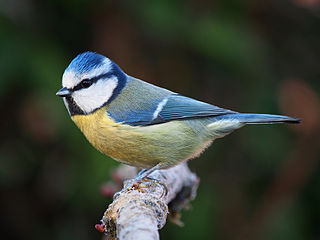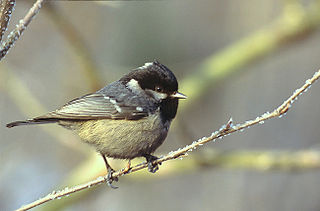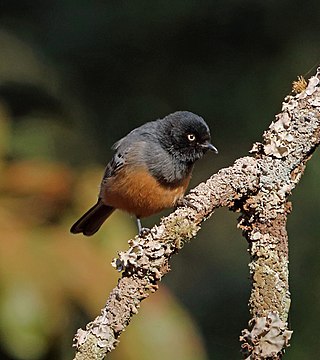
The penduline tits constitute the family, Remizidae, of small passerine birds, related to the true tits. All but the verdin make elaborate bag nests hanging from trees, usually over water.

The Eurasian blue tit is a small passerine bird in the tit family, Paridae. It is easily recognisable by its blue and yellow plumage and small size.

The western plantain-eater, also known as the gray plantain-eater or western gray plantain-eater, is a large member of the turaco family, a group of large arboreal near-passerine birds restricted to Africa.

The Eider is a large seaduck in the genus Somateria. The three extant species all breed in the cooler latitudes of the Northern Hemisphere.

The Eurasian penduline tit or European penduline tit is a passerine bird of the genus Remiz. It is relatively widespread throughout the western Palearctic. It is migratory in the northern part of its range but resident in the southern part.

The grey penduline tit, also known as the African penduline-tit, is a species of bird in the family Remizidae. It is found in Angola, Botswana, Burundi, Republic of the Congo, Democratic Republic of the Congo, Eswatini, Kenya, Malawi, Mozambique, Namibia, Rwanda, South Africa, Tanzania, Uganda, Zambia, and Zimbabwe. Its natural habitats are subtropical or tropical dry forests, dry savanna, and moist savanna. At 8 to 9 cm in length and a weight of 6.5 g (0.23 oz), it is one of the smallest species of bird found in Africa, along with its cousin the Cape penduline tit and the perhaps smaller mouse-colored penduline tit and the tit hylia.

Anthoscopus is a genus of birds in the penduline tit family Remizidae. The genus is restricted to Sub-Saharan Africa, where it ranges from the Sahel to South Africa. Unlike many of the Eurasian penduline, these species are not generally migratory, instead remaining close to their breeding sites year round. A wide range of habitats is occupied by the six species, from deserts to woodlands to rainforest.

The Cape penduline tit or southern penduline tit is a species of bird in the family Remizidae. It is found in Angola, Botswana, Namibia, South Africa, and Zimbabwe. Its natural habitats are dry savannah, subtropical or tropical dry shrubland, and Mediterranean-type shrubby vegetation. At eight centimetres (3 in) in length, it is one of the smallest species of bird found in Africa, along with its cousins the grey penduline tit and the mouse-coloured penduline tit.

The mouse-coloured penduline tit or mouse-colored penduline tit is a species of bird in the family Remizidae. At 8 cm (3.1 in) in length, it is one of the two shortest birds native to Africa, alongside the tit hylia.

The yellow penduline tit is a species of bird in the family Remizidae. This small yellow passerine bird is found in semi-arid savanna regions of West Africa.

The grey tit is a species of bird in the tit family Paridae. It is found in Lesotho and South Africa. Its natural habitats are subtropical or tropical dry shrubland and Mediterranean-type shrubby vegetation.

Parus is a genus of Old World birds in the tit family. It was formerly a large genus containing most of the 50 odd species in the family Paridae. The genus was split into several resurrected genera following the publication of a detailed molecular phylogenetic analysis in 2013. The genus name, Parus, is the Latin word for "tit".

The Chinese penduline tit is a bird in the family Remizidae. The species was first described by Robert Swinhoe in 1870. It is found in China, Japan, North Korea, South Korea, and Russia. There are 10 species in the family Remizidae. They are similar to true tits, but make characteristic penduline nests. They inhabit open fields and wetlands. They have sharp bill tips and the sexes look alike.

The white-crowned penduline tit is a species of bird in the family Remizidae. It is found in Afghanistan, China, India, Kazakhstan, Mongolia, Pakistan, Russia, and Tajikistan.

The flame-crested tanager is a species of bird in the family Thraupidae. It is found in Bolivia, Brazil, Colombia, Ecuador, French Guiana, Guyana, Peru, Suriname, and Venezuela. Its natural habitats are subtropical or tropical moist lowland forests and subtropical or tropical dry shrubland. Ten subspecies are currently recognized.

Cyanistes is a genus of birds in the tit family Paridae. The genus was at one time considered as a subgenus of Parus. In 2005 an article describing a molecular phylogenetic study that had examined mitochondrial DNA sequences from members of the tit family, proposed that a number of subgenera including Cyanistes be elevated to genus status. This proposal was accepted by the International Ornithologists' Union and the British Ornithologists' Union.

Periparus is a genus of birds in the tit family. The birds in the genus were formerly included in Parus but were moved to Periparus when Parus was split into several resurrected genera following the publication of a detailed molecular phylogenetic analysis in 2005. The name Periparus had been introduced for a subgenus of Parus that included the coal tit by the Belgium naturalist Edmond de Sélys Longchamps in 1884. The genus name, is Ancient Greek peri plus the pre-existing genus Parus.

Melaniparus is a genus of birds in the tit family. The species were formerly placed in the speciose genus Parus but were moved to Melaniparus based on a molecular phylogenetic analysis published in 2013 that showed that the members formed a distinct clade. The genus Melaniparus had originally been introduced by the French naturalist Charles Lucien Bonaparte in 1850. The type species was subsequently designated as the southern black tit. The name of the genus combines the Ancient Greek melas, melanos "black" and the genus Parus introduced by Carl Linnaeus in 1758.

Crinifer is a genus of birds in the turaco family. They are restricted to Africa. Formerly, the genus only contained the plantain-eaters, but in 2021, go-away-birds were merged into the genus.

Loriotus is a genus of birds in the tanager family Thraupidae. The species now placed in this genus were formerly placed in the genus Tachyphonus.



















